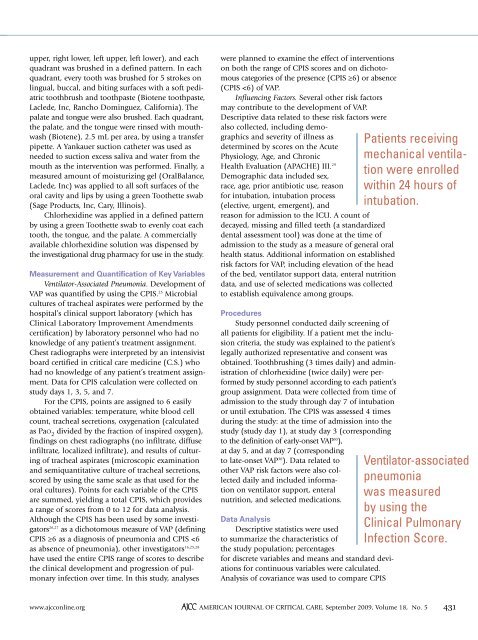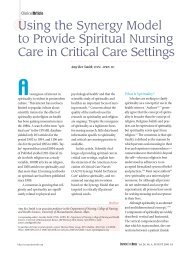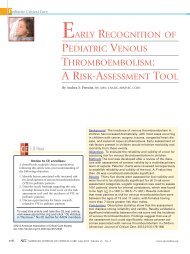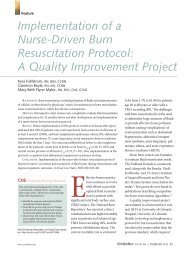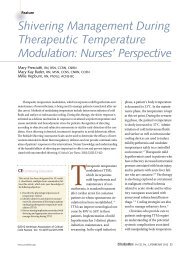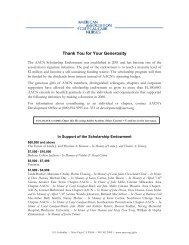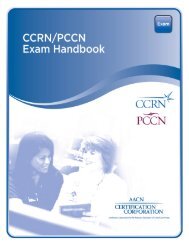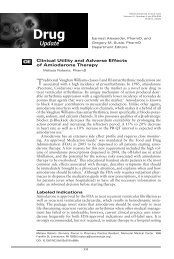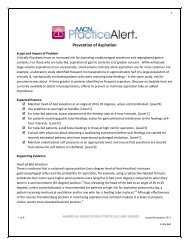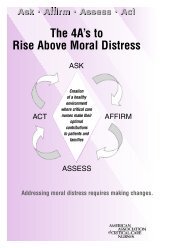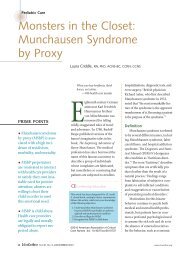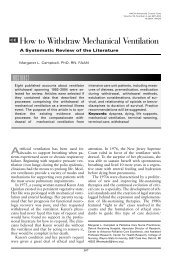Chlorhexidine, Toothbrushing, and Preventing Ventilator Associated ...
Chlorhexidine, Toothbrushing, and Preventing Ventilator Associated ...
Chlorhexidine, Toothbrushing, and Preventing Ventilator Associated ...
Create successful ePaper yourself
Turn your PDF publications into a flip-book with our unique Google optimized e-Paper software.
upper, right lower, left upper, left lower), <strong>and</strong> each<br />
quadrant was brushed in a defined pattern. In each<br />
quadrant, every tooth was brushed for 5 strokes on<br />
lingual, buccal, <strong>and</strong> biting surfaces with a soft pediatric<br />
toothbrush <strong>and</strong> toothpaste (Biotene toothpaste,<br />
Laclede, Inc, Rancho Dominguez, California). The<br />
palate <strong>and</strong> tongue were also brushed. Each quadrant,<br />
the palate, <strong>and</strong> the tongue were rinsed with mouthwash<br />
(Biotene), 2.5 mL per area, by using a transfer<br />
pipette. A Yankauer suction catheter was used as<br />
needed to suction excess saliva <strong>and</strong> water from the<br />
mouth as the intervention was performed. Finally, a<br />
measured amount of moisturizing gel (OralBalance,<br />
Laclede, Inc) was applied to all soft surfaces of the<br />
oral cavity <strong>and</strong> lips by using a green Toothette swab<br />
(Sage Products, Inc, Cary, Illinois).<br />
<strong>Chlorhexidine</strong> was applied in a defined pattern<br />
by using a green Toothette swab to evenly coat each<br />
tooth, the tongue, <strong>and</strong> the palate. A commercially<br />
available chlorhexidine solution was dispensed by<br />
the investigational drug pharmacy for use in the study.<br />
Measurement <strong>and</strong> Quantification of Key Variables<br />
<strong>Ventilator</strong>-<strong>Associated</strong> Pneumonia. Development of<br />
VAP was quantified by using the CPIS. 25 Microbial<br />
cultures of tracheal aspirates were performed by the<br />
hospital’s clinical support laboratory (which has<br />
Clinical Laboratory Improvement Amendments<br />
certification) by laboratory personnel who had no<br />
knowledge of any patient’s treatment assignment.<br />
Chest radiographs were interpreted by an intensivist<br />
board certified in critical care medicine (C.S.) who<br />
had no knowledge of any patient’s treatment assignment.<br />
Data for CPIS calculation were collected on<br />
study days 1, 3, 5, <strong>and</strong> 7.<br />
For the CPIS, points are assigned to 6 easily<br />
obtained variables: temperature, white blood cell<br />
count, tracheal secretions, oxygenation (calculated<br />
as PaO 2 divided by the fraction of inspired oxygen),<br />
findings on chest radiographs (no infiltrate, diffuse<br />
infiltrate, localized infiltrate), <strong>and</strong> results of culturing<br />
of tracheal aspirates (microscopic examination<br />
<strong>and</strong> semiquantitative culture of tracheal secretions,<br />
scored by using the same scale as that used for the<br />
oral cultures). Points for each variable of the CPIS<br />
are summed, yielding a total CPIS, which provides<br />
a range of scores from 0 to 12 for data analysis.<br />
Although the CPIS has been used by some investigators<br />
26,27 as a dichotomous measure of VAP (defining<br />
CPIS ≥6 as a diagnosis of pneumonia <strong>and</strong> CPIS


